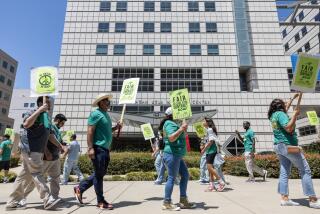Paramedics Are Ready to Strike : Labor: San Diego firefighters, who would be used as replacements, say patients would suffer because of their lack of emergency training.
A lengthy contract dispute between Hartson Medical Services and the Service Employees International Union, Local 102 has escalated to threats of a paramedic strike by the union and angered San Diego firefighters, who would be used as relatively untrained replacements in the event of a walkout.
Paramedics voted last week to authorize a strike against the ambulance company. The final tally, which was released Friday, showed that employees approved a strike by a vote of 129 to 22. Eliseo Medina, president of Local 102, said a strike deadline could be set this week if the union feels that no progress is made Tuesday, when both sides are to meet at a bargaining session arranged by a state mediator.
Although city officials have said that local firefighters would be more than adequate as replacements for striking paramedics, an official of the Fire Fighters Union said firefighters are unqualified to provide anything but basic life-support systems and warned that some patients may suffer or die because of it.
Local 102 and Hartson have been negotiating the first-ever labor contract for the company since April. Paramedics voted to organize under Local 102 in February, after the National Labor Relations Board nullified the results of an August, 1988, election, saying union officials coerced some employees to vote.
Hartson has a $6.8-million paramedic contract with San Diego that expires in June, 1991. Under terms of the contract, Hartson runs the program and hires the paramedics and technicians, but the city owns the ambulances and emergency equipment.
A strike could involve about 160 paramedics. Although about 175 emergency medical technicians are also union members, they would not be involved in a strike, union officials said.
Medina charged that Hartson officials are stalling and have refused to enter serious negotiations with the union. Hartson spokeswoman Sharon Henry countered that the union is posturing, and said both sides “have probably reached more agreements than disagreements,” but she conceded there are still “very significant stumbling blocks” to be overcome.
Both sides said they are far apart on the issues of wages and employee scheduling. Beginning pay for technicians is $5 an hour, and top pay for certified paramedics is $9.55 an hour, based on a 56-hour week, after seven years of experience. Mike Meoli, a paramedic fired by Hartson in December who now works for the union, said the average San Diego paramedic has only two years’ experience because most Hartson employees leave for better-paying jobs at other agencies after two years.
According to union figures, San Diego paramedics are the lowest paid in the county. Carlsbad paramedics, who are a part of the Fire Department, are the highest paid, earning $31,397 a year. The average paramedic wage in the county is more than 24% higher than Hartson’s, union officials said. Paramedics in Los Angeles and San Francisco on the average earn 62% more, they said.
“We’re in support of the paramedics. It’s ridiculous what they get paid,” said John Thomson, vice president of the San Diego Fire Fighters Local 145.
In the event of a strike, city officials said, they will use off-duty firefighters to man the ambulances in order to provide paramedic service. Hartson officials said they would also use medical technicians to replace paramedics if there were a strike. Although medical technicians are certified, they are not qualified to perform the more complex lifesaving duties done by paramedics.
Thomson warned that “the public will suffer” if firefighters and other less qualified personnel are used as replacements.
“All we would be doing is basic life-support system. Paramedics do advanced life-support system. . . . Basically, all we would be doing is scooping and hauling,” Thomson said.
Most San Diegans lump firefighters and paramedics together, because both groups usually respond to an emergency. But the fact is that only a handful of San Diego firefighters are certified as paramedics. This means firefighters are not qualified, or authorized, to give a patient intravenous treatment or to use most of the equipment that paramedics routinely use on calls.
“It goes beyond all of that. Paramedics make real life-or-death decisions that we don’t have to make. Do you take a patient with trauma to a trauma hospital or to the closest hospital? If a child is injured, do you take him to Children’s Hospital or to the nearest hospital? The public has to be made aware that it’s paramedics who make these important decisions.
“We don’t, because we’re not qualified to make them,” Thomson said.
“We can’t even give a patient medication. The public will suffer because there’s nothing more we can do other than give them oxygen on the way to the hospital and, if they die, perform CPR. Like I said before, all we’re going to be doing is scooping and hauling,” he said.
Thomson said firefighters “have been thrown in the middle of this dispute” by city officials. The Fire Fighters Union’s contract with the city forbids members from engaging in strikes, boycotts or other job actions. The city plans to pay off-duty firefighters overtime to fill in as paramedic replacements, Thomson said, then turn around and bill Hartson.
But Thomson said the city “is also caught in a bind.” San Diego is obligated to provide emergency services and is looking at probably the most viable alternative in case of a strike, he said. However, he also said firefighters “are in support of the paramedics” and are urging Hartson to reach an agreement with Local 102.
One problem facing city officials is that they do not want to give the impression that they have taken sides in the dispute. The union has already complained that the city and the County Emergency Medical Services agency, which certifies paramedics, are planning “strike breaking” action.
Deputy City Manager Maureen Stapleton, who is in charge of the city’s contingency plans in the event of a strike, did not return repeated telephone calls.
Because Hartson only employs paramedics and uses city-owned equipment to make emergency calls, the union has offered “a plan to strike Hartson and work for the city,” Medina said. Under the union’s proposal, paramedics would continue working for the city at no pay, but Medina said Stapleton “prefers to downgrade the system” and has rejected the union’s proposal.
“Currently, the paramedics put an emergency-room system at your house. With the downgraded system that the city manager’s office wants to use if we strike, all they will do is put you on a gurney and take you to the hospital,” Medina said.
The union hoped to hurt the ambulance company in the pocketbook by volunteering to work free. In addition to denying Hartson the ambulances and equipment needed to perform paramedic services, the company would be unable to collect on its contract and would lose income from every call.
Hartson spokeswoman Henry said the city allows the company to charge a patient no more than $281 per call. Henry said the fee usually includes a basic charge, mileage costs, supplies used and services performed. In December, Hartson made about 4,500 calls in San Diego and transported about 2,500 patients, Henry said.
Thomson said the Fire Fighters Union supports the paramedics’ proposal to work for the city while striking Hartson.
“It’s a sensible alternative because then the quality of patient care would not suffer,” he said.
Henry, meanwhile, said Hartson has recruited 14 certified paramedics from its operations in Las Vegas and Ft. Worth to work in San Diego in case of a strike. This move has stirred another controversy between Local 102 and County Emergency Medical Services.
In a letter to the union, Gail Cooper, chief of the agency, said her office has taken a neutral stance in the labor dispute. However, Medina charged in a letter to Cooper that she is in “Hartson’s pocket” and later accused her of authorizing the recruiting of strikebreakers.
The controversy centers on a trip that three employees of the Emergency Medical Services Training Institute took to Las Vegas and Ft. Worth for a fee paid by Hartson. The institute, which is situated at UCSD Medical Center, contracts with the county to test paramedic applicants seeking certification.
Medina argued that Cooper approved of the trip by the institute’s employees. Karen Jones, an institute official, did not return phone calls. However, Henry said the trip was necessary in order to “take the county test” to paramedics in Las Vegas and Ft. Worth, who will have to be certified to work in San Diego by County Emergency Medical Services if local paramedics strike.
“San Diego County requires its own certification, and we cross-certified them in case they have to work here,” Henry said. “We took the test to them. It seemed more expedient that way. We certified 14 people, and they will be used only if there is a labor action.”
Cooper declined to comment on the union’s charges that she is siding with Hartson in the dispute. But agency spokesman Steve Escoboza brushed aside Medina’s charge that the county has sided with the ambulance company.
“We are neutral. I want to underscore the idea that we have a responsibility under county statutes . . . that requires us to do these certification activities. The perception may be that we’re involved in activities inconsistent with that neutrality. It’s a position we don’t want to be in, but I understand how he (Medina) can misconstrue this.”
Besides wages and employee schedules, Hartson and the union are also far apart on the firings of paramedics Meoli and Mike Macaluso. Henry declined to elaborate on the firings, saying only that “they were terminated for violating company policy as it relates to responses and response time.” The city’s contract with Hartson requires paramedics to respond to a call within 10 minutes.
Medina charged that the two men were fired for their union activities. Hartson has offered to settle the dispute by hiring a panel of retired judges as arbitrators, Medina said. But the union wants the matter arbitrated by “an experienced labor arbitrator,” he added.
More to Read
Sign up for Essential California
The most important California stories and recommendations in your inbox every morning.
You may occasionally receive promotional content from the Los Angeles Times.










